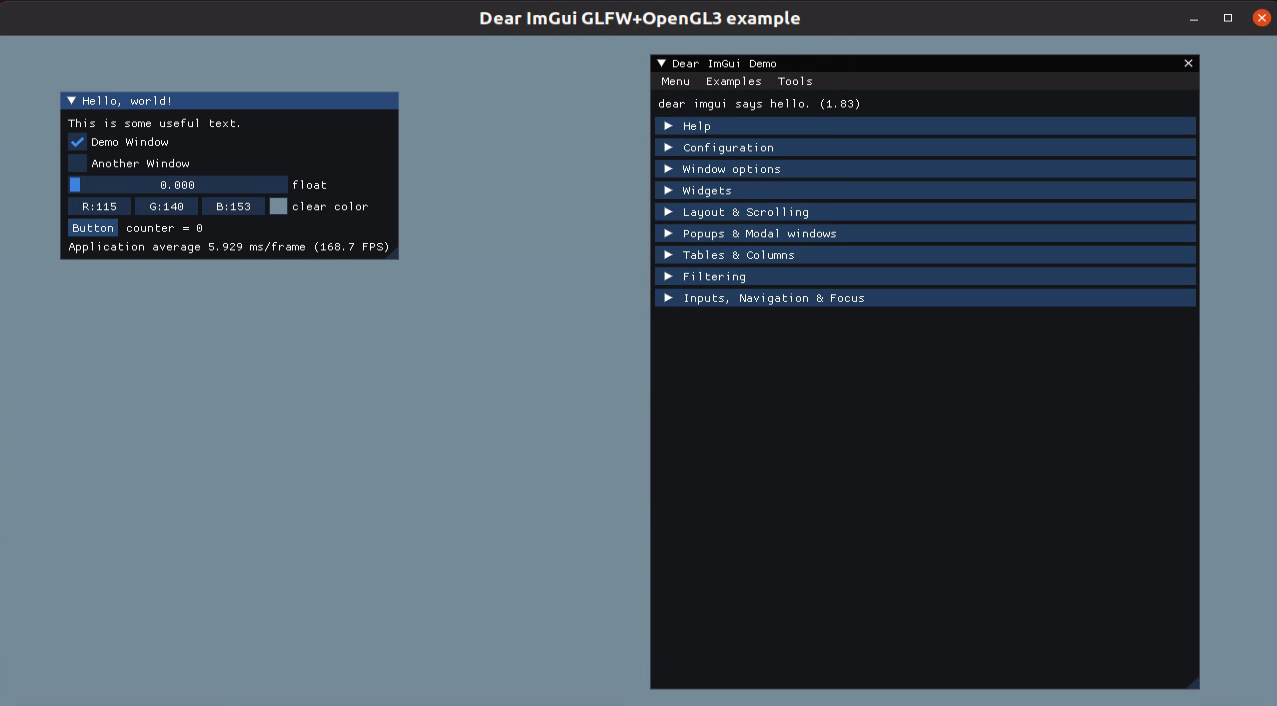😏★,°:.☆( ̄▽ ̄)/$:.°★ 😏
这篇文章主要介绍ImGui图形用户界面库配置与使用。
无专精则不能成,无涉猎则不能通。——梁启超
欢迎来到我的博客,一起学习,共同进步。
喜欢的朋友可以关注一下,下次更新不迷路🥞
文章目录
😏1. 项目介绍
项目Github地址:
https://github.com/ocornut/imgui
Dear ImGui
(
ImGui
) 是一个开源的、用 C++ 编写的图形用户界面(GUI)库。它由OCornut创建,旨在为应用程序和工具提供创建用户界面的简单高效的方式。
以下是
Dear ImGui
的一些主要特性和特点:
1.即时模式 GUI:ImGui 遵循即时模式 GUI 的范例,用户界面不是通过保留模式或对象层次结构构建的。相反,每一帧都需要重新创建和绘制用户界面。这种设计使得创建和更新界面变得非常灵活和直观。
2.轻量级和可嵌入性:ImGui 是一个轻量级库,只有几个文件组成,可轻松嵌入到现有项目中。它没有任何外部依赖,使得集成和部署变得非常简单。
3.跨平台支持:ImGui 可以在多个平台上运行,包括 Windows、MacOS、Linux 和其他一些操作系统。它提供了与底层图形 API(如OpenGL、DirectX)的集成,以便在不同平台上绘制用户界面。
4.简单易用的 API:ImGui 提供了一个简单直观的 API,使得创建用户界面变得非常容易。您可以使用各种控件(如按钮、文本框、滑块等)来构建界面,并通过监听用户输入和响应事件来实现交互。
5.自定义性强:ImGui 具有强大的自定义能力,您可以自定义主题、样式和控件外观以满足您的需求。此外,您还可以编写自定义的渲染器,以实现与不同图形 API 的集成。
Dear ImGui
是一个简单、灵活且强大的 GUI 库,适用于各种应用程序和工具的用户界面开发。无论是创建原型、调试工具还是构建实际应用程序,它都提供了一套方便的工具和框架来简化界面开发过程。
😊2. 环境配置
下面进行环境配置:
# windows vs# windows端需要预装directx,VS的Kit中默认会有# 源码中的example下有示例VS工程(.sln),下载源码后直接用VS打开运行
# windows clion# CMakeLists.txt示例,提前装好了glfw+glad+freeglut+opencv
cmake_minimum_required(VERSION 3.19)
project(opengl_demo)
set(CMAKE_CXX_STANDARD 14)
include_directories("./env/include")
link_directories("./env/lib")
include_directories("./env/imgui")
include_directories("./env/imgui/backends")
set(OpenCV_DIR "D:/develop/opencv341_mingw/x64/mingw/lib")
find_package(OpenCV 3 REQUIRED)
MESSAGE("OpenCV version : ${OpenCV_VERSION}")
include_directories(${OpenCV_INCLUDE_DIRS})
link_directories(${OpenCV_LIBRARIES})# ${OpenCV_LIB_DIR}
file(GLOB IMGUI "./env/imgui/*.cpp")# 1.80
add_executable(opengl_demo main.cpp env/glad.c ${IMGUI})
target_link_libraries(opengl_demo
glfw3 # 3.3.9
opengl32
freeglut # 3.4.0
glu32
${OpenCV_LIBRARIES}
xinput
)
# ubuntu cmakesudoaptinstall libglfw3 libglfw3-dev # 安装glfw# 一个博主已经写了一个基于cmake的示例,这里引用一下 http://t.csdnimg.cn/LDY5H
https://github.com/tashaxing/imgui_cmake_starter
# 包含了imgui 1.83的源码和示例程序,直接编译即可
😆3. 使用说明
运行示例:
windows VS直接生成运行即可,ubuntu下cmake编译指令如下:
mkdir build &&cd build
cmake ..make
./imgui_cmake_starter

Imgui的示例代码:
#include"imgui.h"#include"imgui_impl_glfw.h"#include"imgui_impl_opengl3.h"#include<iostream>#ifdefined(IMGUI_IMPL_OPENGL_ES2)#include<GLES2/gl2.h>// About Desktop OpenGL function loaders:// Modern desktop OpenGL doesn't have a standard portable header file to load OpenGL function pointers.// Helper libraries are often used for this purpose! Here we are supporting a few common ones (gl3w, glew, glad).// You may use another loader/header of your choice (glext, glLoadGen, etc.), or chose to manually implement your own.#elifdefined(IMGUI_IMPL_OPENGL_LOADER_GL3W)#include<GL/gl3w.h>// Initialize with gl3wInit()#elifdefined(IMGUI_IMPL_OPENGL_LOADER_GLEW)#include<GL/glew.h>// Initialize with glewInit()#elifdefined(IMGUI_IMPL_OPENGL_LOADER_GLAD)#include<glad/glad.h>// Initialize with gladLoadGL()#elifdefined(IMGUI_IMPL_OPENGL_LOADER_GLAD2)#include<glad/gl.h>// Initialize with gladLoadGL(...) or gladLoaderLoadGL()#elifdefined(IMGUI_IMPL_OPENGL_LOADER_GLBINDING2)#defineGLFW_INCLUDE_NONE// GLFW including OpenGL headers causes ambiguity or multiple definition errors.#include<glbinding/Binding.h>// Initialize with glbinding::Binding::initialize()#include<glbinding/gl/gl.h>usingnamespace gl;#elifdefined(IMGUI_IMPL_OPENGL_LOADER_GLBINDING3)#defineGLFW_INCLUDE_NONE// GLFW including OpenGL headers causes ambiguity or multiple definition errors.#include<glbinding/glbinding.h>// Initialize with glbinding::initialize()#include<glbinding/gl/gl.h>usingnamespace gl;#else#includeIMGUI_IMPL_OPENGL_LOADER_CUSTOM#endif// Include glfw3.h after our OpenGL definitions#include<GLFW/glfw3.h>// [Win32] Our example includes a copy of glfw3.lib pre-compiled with VS2010 to maximize ease of testing and compatibility with old VS compilers.// To link with VS2010-era libraries, VS2015+ requires linking with legacy_stdio_definitions.lib, which we do using this pragma.// Your own project should not be affected, as you are likely to link with a newer binary of GLFW that is adequate for your version of Visual Studio.#ifdefined(_MSC_VER)&&(_MSC_VER >=1900)&&!defined(IMGUI_DISABLE_WIN32_FUNCTIONS)#pragmacomment(lib,"legacy_stdio_definitions")#endifstaticvoidglfw_error_callback(int error,constchar* description){fprintf(stderr,"Glfw Error %d: %s\n", error, description);}intmain(int argc,char** argv){// Setup windowglfwSetErrorCallback(glfw_error_callback);if(!glfwInit())return1;// Decide GL+GLSL versions#ifdefined(IMGUI_IMPL_OPENGL_ES2)// GL ES 2.0 + GLSL 100constchar* glsl_version ="#version 100";glfwWindowHint(GLFW_CONTEXT_VERSION_MAJOR,2);glfwWindowHint(GLFW_CONTEXT_VERSION_MINOR,0);glfwWindowHint(GLFW_CLIENT_API, GLFW_OPENGL_ES_API);#elifdefined(__APPLE__)// GL 3.2 + GLSL 150constchar* glsl_version ="#version 150";glfwWindowHint(GLFW_CONTEXT_VERSION_MAJOR,3);glfwWindowHint(GLFW_CONTEXT_VERSION_MINOR,2);glfwWindowHint(GLFW_OPENGL_PROFILE, GLFW_OPENGL_CORE_PROFILE);// 3.2+ onlyglfwWindowHint(GLFW_OPENGL_FORWARD_COMPAT, GL_TRUE);// Required on Mac#else// GL 3.0 + GLSL 130constchar* glsl_version ="#version 130";glfwWindowHint(GLFW_CONTEXT_VERSION_MAJOR,3);glfwWindowHint(GLFW_CONTEXT_VERSION_MINOR,0);//glfwWindowHint(GLFW_OPENGL_PROFILE, GLFW_OPENGL_CORE_PROFILE); // 3.2+ only//glfwWindowHint(GLFW_OPENGL_FORWARD_COMPAT, GL_TRUE); // 3.0+ only#endif// Create window with graphics context
GLFWwindow* window =glfwCreateWindow(1280,720,"Dear ImGui GLFW+OpenGL3 example",NULL,NULL);if(window ==NULL)return1;glfwMakeContextCurrent(window);glfwSwapInterval(1);// Enable vsync// Initialize OpenGL loader#ifdefined(IMGUI_IMPL_OPENGL_LOADER_GL3W)bool err =gl3wInit()!=0;#elifdefined(IMGUI_IMPL_OPENGL_LOADER_GLEW)bool err =glewInit()!= GLEW_OK;#elifdefined(IMGUI_IMPL_OPENGL_LOADER_GLAD)bool err =gladLoadGL()==0;#elifdefined(IMGUI_IMPL_OPENGL_LOADER_GLAD2)bool err =gladLoadGL(glfwGetProcAddress)==0;// glad2 recommend using the windowing library loader instead of the (optionally) bundled one.#elifdefined(IMGUI_IMPL_OPENGL_LOADER_GLBINDING2)bool err =false;
glbinding::Binding::initialize();#elifdefined(IMGUI_IMPL_OPENGL_LOADER_GLBINDING3)bool err =false;
glbinding::initialize([](constchar* name){return(glbinding::ProcAddress)glfwGetProcAddress(name);});#elsebool err =false;// If you use IMGUI_IMPL_OPENGL_LOADER_CUSTOM, your loader is likely to requires some form of initialization.#endifif(err){fprintf(stderr,"Failed to initialize OpenGL loader!\n");return1;}// Setup Dear ImGui contextIMGUI_CHECKVERSION();ImGui::CreateContext();
ImGuiIO& io =ImGui::GetIO();(void)io;//io.ConfigFlags |= ImGuiConfigFlags_NavEnableKeyboard; // Enable Keyboard Controls//io.ConfigFlags |= ImGuiConfigFlags_NavEnableGamepad; // Enable Gamepad Controls// Setup Dear ImGui styleImGui::StyleColorsDark();//ImGui::StyleColorsClassic();// Setup Platform/Renderer backendsImGui_ImplGlfw_InitForOpenGL(window,true);ImGui_ImplOpenGL3_Init(glsl_version);// Load Fonts// - If no fonts are loaded, dear imgui will use the default font. You can also load multiple fonts and use ImGui::PushFont()/PopFont() to select them.// - AddFontFromFileTTF() will return the ImFont* so you can store it if you need to select the font among multiple.// - If the file cannot be loaded, the function will return NULL. Please handle those errors in your application (e.g. use an assertion, or display an error and quit).// - The fonts will be rasterized at a given size (w/ oversampling) and stored into a texture when calling ImFontAtlas::Build()/GetTexDataAsXXXX(), which ImGui_ImplXXXX_NewFrame below will call.// - Read 'docs/FONTS.md' for more instructions and details.// - Remember that in C/C++ if you want to include a backslash \ in a string literal you need to write a double backslash \\ !//io.Fonts->AddFontDefault();//io.Fonts->AddFontFromFileTTF("../../misc/fonts/Roboto-Medium.ttf", 16.0f);//io.Fonts->AddFontFromFileTTF("../../misc/fonts/Cousine-Regular.ttf", 15.0f);//io.Fonts->AddFontFromFileTTF("../../misc/fonts/DroidSans.ttf", 16.0f);//io.Fonts->AddFontFromFileTTF("../../misc/fonts/ProggyTiny.ttf", 10.0f);//ImFont* font = io.Fonts->AddFontFromFileTTF("c:\\Windows\\Fonts\\ArialUni.ttf", 18.0f, NULL, io.Fonts->GetGlyphRangesJapanese());//IM_ASSERT(font != NULL);// Our statebool show_demo_window =true;bool show_another_window =false;
ImVec4 clear_color =ImVec4(0.45f,0.55f,0.60f,1.00f);// Main loopwhile(!glfwWindowShouldClose(window)){// Poll and handle events (inputs, window resize, etc.)// You can read the io.WantCaptureMouse, io.WantCaptureKeyboard flags to tell if dear imgui wants to use your inputs.// - When io.WantCaptureMouse is true, do not dispatch mouse input data to your main application.// - When io.WantCaptureKeyboard is true, do not dispatch keyboard input data to your main application.// Generally you may always pass all inputs to dear imgui, and hide them from your application based on those two flags.glfwPollEvents();// Start the Dear ImGui frameImGui_ImplOpenGL3_NewFrame();ImGui_ImplGlfw_NewFrame();ImGui::NewFrame();// 1. Show the big demo window (Most of the sample code is in ImGui::ShowDemoWindow()! You can browse its code to learn more about Dear ImGui!).if(show_demo_window)ImGui::ShowDemoWindow(&show_demo_window);// 2. Show a simple window that we create ourselves. We use a Begin/End pair to created a named window.{staticfloat f =0.0f;staticint counter =0;ImGui::Begin("Hello, world!");// Create a window called "Hello, world!" and append into it.ImGui::Text("This is some useful text.");// Display some text (you can use a format strings too)ImGui::Checkbox("Demo Window",&show_demo_window);// Edit bools storing our window open/close stateImGui::Checkbox("Another Window",&show_another_window);ImGui::SliderFloat("float",&f,0.0f,1.0f);// Edit 1 float using a slider from 0.0f to 1.0fImGui::ColorEdit3("clear color",(float*)&clear_color);// Edit 3 floats representing a colorif(ImGui::Button("Button"))// Buttons return true when clicked (most widgets return true when edited/activated)
counter++;ImGui::SameLine();ImGui::Text("counter = %d", counter);ImGui::Text("Application average %.3f ms/frame (%.1f FPS)",1000.0f/ImGui::GetIO().Framerate,ImGui::GetIO().Framerate);ImGui::End();}// 3. Show another simple window.if(show_another_window){ImGui::Begin("Another Window",&show_another_window);// Pass a pointer to our bool variable (the window will have a closing button that will clear the bool when clicked)ImGui::Text("Hello from another window!");if(ImGui::Button("Close Me"))
show_another_window =false;ImGui::End();}// RenderingImGui::Render();int display_w, display_h;glfwGetFramebufferSize(window,&display_w,&display_h);glViewport(0,0, display_w, display_h);glClearColor(clear_color.x * clear_color.w, clear_color.y * clear_color.w, clear_color.z * clear_color.w, clear_color.w);glClear(GL_COLOR_BUFFER_BIT);ImGui_ImplOpenGL3_RenderDrawData(ImGui::GetDrawData());glfwSwapBuffers(window);}// CleanupImGui_ImplOpenGL3_Shutdown();ImGui_ImplGlfw_Shutdown();ImGui::DestroyContext();glfwDestroyWindow(window);glfwTerminate();return0;}

以上。
版权归原作者 DevFrank 所有, 如有侵权,请联系我们删除。